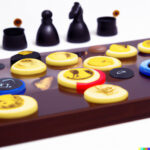Are you ready to solve a murder mystery? Look no further than the Clue Classic Detective Board Game. This beloved game has been challenging players to use their deductive reasoning skills for decades. Whether you’re a seasoned sleuth or a newbie to the world of mystery games, Clue offers endless hours of entertainment and suspense.
The history and origins of Clue Classic Detective Board Game date back to the 1940s, when it was first created by Anthony E. Pratt, a British musician. Since then, it has become a timeless classic that has been enjoyed by generations of players around the world. The game’s enduring popularity speaks to its ability to captivate and engage players of all ages.
What sets Clue apart from other board games is its unique combination of strategy, deduction, and suspense. Players must navigate through the game board, collecting clues and using deductive reasoning to determine which suspect, weapon, and room were involved in the murder.
With each turn, new information is revealed, keeping players on the edge of their seats as they inch closer to solving the mystery. Keep reading for an in-depth look at the game board and pieces, as well as tips for mastering this classic detective game.
As we delve deeper into the world of Clue Classic Detective Board Game in this article, you’ll learn about its rich history, detailed gameplay mechanics, and intriguing variations that have kept it relevant in pop culture for decades. So gather your fellow detectives and prepare for an immersive game night experience with Clue.
History and Origins of Clue Classic Detective Board Game
The history and origins of the classic detective board game Clue can be traced back to the United Kingdom in 1944, where it was first devised by Anthony E. Pratt, a solicitor’s clerk. Pratt designed the game as a way to pass the time during air raid drills and based it on murder mystery novels.
Originally named “Murder. “, the game was eventually licensed to Waddingtons in the UK and Parker Brothers in the US, where it was rebranded as “Cluedo” and “Clue,” respectively.
The game’s original setting was Tudor Mansion, and its characters were Dr. Black (later renamed Mr. Boddy or Dr. Black), Miss Scarlett, Colonel Mustard, Mrs. White, Mr. Green, Mrs. Peacock, and Professor Plum. The gameplay revolved around players moving from room to room in the mansion to collect clues about who committed a murder with which weapon and in what room.
Throughout its history, Clue has undergone various changes and updates; for example, minor alterations have been made to some editions’ character names and weapons-and even the rooms of Tudor Mansion were changed in international versions of the classic game.
In subsequent decades since its creation, Clue has become one of the most widely known and popular board games globally-inspiring movies, TV series episodes, books, theatrical productions-becoming part of pop culture consciousness-which is undoubtedly a testament to its lasting impact on entertainment beyond simply being a tabletop experience.
| History | Details |
|---|---|
| Origins | Developed by Anthony E. Pratt during WWII |
| Name Changes | “Murder.” to “Cluedo” (UK) & “Clue” (US) |
| Global Popularity | Inspired movies, TV shows & more |
Overview of the Game Board and Pieces
Clue Classic Detective Board Game is a beloved board game that has been entertaining players for decades. The game is set in a manor where players take on the roles of characters trying to solve a murder mystery. The game board is designed to represent different rooms in the manor, and the pieces represent the characters, weapons, and clues that players will use to deduce who committed the murder.
The game board itself is divided into different rooms such as the Study, Hall, Lounge, Conservatory, and more. Each room has a specific color associated with it and is interconnected by various passageways. Additionally, there are secret passages that allow players to move quickly from one room to another. The game also includes cards representing the suspects, weapons, and rooms involved in the murder.
The playing pieces in Clue Classic Detective Board Game consist of character pawns representing Miss Scarlett, Colonel Mustard, Mrs. White, Mr. Green, Mrs. Peacock, and Professor Plum along with weapon tokens such as a candlestick or lead pipe. The game also includes notepads for keeping track of information gathered during gameplay. These elements come together to create an immersive experience for players as they work to solve the mystery at hand.
| Room | Description |
|---|---|
| Study | A cozy room furnished with academics in mind. |
| Hall | A grand entrance area leading into other parts of the manor. |
| Lounge | A comfortable space designed for relaxation. |
| Conservatory | A room filled with natural light and plants. |
How to Play Clue Classic Detective Board Game
Clue Classic Detective Board Game is a thrilling game that requires strategy, deduction, and a little bit of luck. In this section, we will explore the rules and mechanics of playing Clue Classic Detective Board Game to help you become a master detective.
Objective
The main objective of Clue Classic Detective Board Game is to determine the three main aspects of a murder: the murderer, the weapon used, and the room in which the crime took place. Players move around the game board to gather information by making suggestions and collecting evidence to ultimately make an accusation.
Game Setup
To begin the game, each player selects a character token representing a potential suspect in the murder. The suspect tokens are then placed on their respective start spaces on the board. Additionally, players receive a notepad that includes all possible suspects, weapons, and rooms to keep track of clues gained throughout the game.
Gameplay
Players take turns rolling dice and moving their character tokens around the game board. When landing on a room space, players can make suggestions about who they suspect is the murderer and with what weapon. The other players then use their hand of cards to refute or confirm the suggestion.
The game ends when one player feels confident enough to make an accusation about the murderer, weapon, and room. If correct, that player wins; if wrong, they are eliminated from the game.
Understanding these fundamental rules of how to play Clue Classic Detective Board Game will set you on your way to becoming a formidable detective in this classic mystery-solving adventure.
Strategy Tips and Tricks for Winning Clue Classic Detective Board Game
Clue Classic Detective Board Game is not just about luck, but also about strategy. As players navigate through the game board to solve the mystery, employing certain tips and tricks can give them an edge over their opponents.
Take Notes and Pay Attention
One of the most important strategies in Clue Classic Detective Board Game is to take thorough notes and pay close attention to the actions of other players. By keeping track of which cards are shown or not shown during the game, players can deduce which cards each player is holding and narrow down the possibilities to solve the mystery quicker.
Use Process of Elimination
Once a player has gathered some information through note-taking, they should use process of elimination to figure out who, where, and with what weapon the crime was committed. By systematically crossing off possibilities on their clue sheet based on the information they have obtained, players can eventually piece together the solution.
Mislead Your Opponents
To throw off other players and protect one’s own cards, it can be beneficial to make false suggestions during the game. By strategically suggesting combinations that they know are not accurate based on their own notes, players can mislead their opponents while moving themselves closer to solving the mystery.
By implementing these strategies and using keen observation skills, players can increase their chances of winning Clue Classic Detective Board Game. It’s a game of deduction and logic that rewards those who play strategically and think critically throughout gameplay.
Variations and Editions of Clue Classic Detective Board Game
Clue Classic Detective Board Game has spawned various editions and variations since its original release. These different versions offer unique twists and themes, giving players a fresh and exciting experience with each edition. Here are some of the most popular variations and editions of Clue Classic Detective Board Game:
- Clue Master Detective: This version features additional suspects, weapons, and rooms, making the game more challenging and complex. It also includes a larger game board to accommodate the extra elements.
- Junior Clue: Designed for younger players, this edition simplifies the gameplay and provides a more kid-friendly theme. The characters are replaced by animals, and the mystery is less intense.
- Clue FX: This electronic version adds sound effects and voiceovers to enhance the gaming experience. The game board also features interactive elements that respond to player actions.
In addition to these variations, there have been numerous themed editions of Clue Classic Detective Board Game, tying in with popular franchises such as Harry Potter, The Simpsons, and Downton Abbey. These special editions replace the classic mansion setting with locations from these respective universes and incorporate characters and items relevant to the theme.
Furthermore, there are regional editions tailored to specific countries or cities, incorporating local landmarks or famous figures into the gameplay. These editions provide a personalized touch for players from those regions while maintaining the core mechanics of the original game. With its diverse range of editions and variations, Clue Classic Detective Board Game continues to captivate both new and seasoned players alike.
Pop Culture References and Influence of Clue Classic Detective Board Game
The Clue Classic Detective Board Game has become a staple in popular culture, making appearances in various forms of media such as movies, television shows, books, and even video games. Here are some notable pop culture references and influences of the game:
- Movies: The board game has been adapted into a feature film in 1985, titled “Clue,” which was a comedy mystery directed by Jonathan Lynn. The movie garnered a cult following and is known for its multiple endings, inspired by the game’s mechanics.
- Television Shows: Clue has been referenced in numerous TV series such as “The Simpsons,” “Friends,” and “Parks and Recreation.” It has also been featured in game show formats like “Jeopardy.” and “Wheel of Fortune.”
- Books: Clue has made its way into literature with various adaptations and spin-off novels based on the characters and storylines from the original board game.
The influence of Clue Classic Detective Board Game can also be seen in modern-day board games and video games. Several adaptations and spin-offs have been created over the years, keeping the legacy of the classic detective game alive.
Overall, the impact of Clue Classic Detective Board Game on pop culture is undeniable, showing its enduring appeal across different forms of entertainment. Its unique blend of mystery, strategy, and deduction continues to captivate audiences of all ages.
Conclusion and Final Thoughts on Clue Classic Detective Board Game
In conclusion, Clue Classic Detective Board Game has stood the test of time as a beloved and iconic game for players of all ages. Its rich history and origins, along with its intriguing gameplay and strategy, have cemented its place as a classic in the world of board games.
The game’s unique combination of deduction, strategy, and mystery makes it an engaging and entertaining experience for players. Whether playing with family or friends, Clue Classic Detective Board Game offers endless hours of fun as players work to unravel the mystery and uncover the elusive culprit.
With various editions and variations available, Clue Classic Detective Board Game continues to captivate new audiences while also retaining its nostalgic appeal for long-time fans. Its influence in pop culture further solidifies its status as a timeless classic that has left a lasting impact on the world of entertainment.
Overall, Clue Classic Detective Board Game remains a beloved favorite among board game enthusiasts, offering a timeless experience that continues to intrigue and delight players around the world. Its enduring popularity is a testament to the game’s enduring appeal and its ability to bring people together for an exciting and memorable gaming experience.
Frequently Asked Questions
How Do You Play Clue the Classic Detective Game?
Clue, the classic detective game, is played by moving around the board to collect clues and determine which suspect, weapon, and room card are in the envelope. Players roll dice to move through different rooms and make suggestions about who committed the crime. The goal is to be the first player to solve the mystery by making an accusation.
What Was the Original Version of the Game Clue?
The original version of the game Clue was called “Cluedo” and was created in 1949 by Anthony E. Pratt. It was marketed as a game of “super-sleuth” and featured many of the same elements as the Clue game we know today, including a murder mystery plot and a list of potential suspects, weapons, and rooms.
Are There Different Versions of Clue Board Game?
Different versions of the Clue board game have been released over the years with variations in themes, characters, settings, or special editions with added features. Some versions include “The Simpsons Clue,” “Harry Potter Clue,” and “Sherlock.”

I love playing all kinds of games – from classics like Monopoly to modern favourites like Ticket to Ride.
I created this blog as a way to share my love of board games with others, and provide information on the latest releases and news in the industry.





